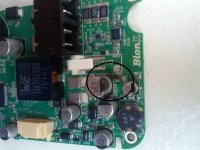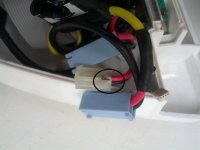Hmm, orange indicator after just two days - I think I may also have some part of the BMS consume energy.
I would sure like to find out if it's likely to be a component that could potentially be replaced by a non-bionx technician, as I don't have a Bionx dealer within driving distance.
EDIT: The voltage reads 52.5v, and I can't detect any heat from the PCB. I did find some black spots upon close inspection though, as encircled on these pictures. The top of that capacitor is meant to be black, however the side of it is not.
I would sure like to find out if it's likely to be a component that could potentially be replaced by a non-bionx technician, as I don't have a Bionx dealer within driving distance.
EDIT: The voltage reads 52.5v, and I can't detect any heat from the PCB. I did find some black spots upon close inspection though, as encircled on these pictures. The top of that capacitor is meant to be black, however the side of it is not.





